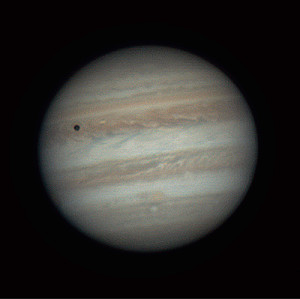Glossary term: Transit
Description: Un transit se produit lorsqu'un corps céleste passe entre un autre corps céleste de taille angulaire plus importante et l'observateur. Du point de vue de l'observateur, le corps céleste obscurcissant se déplace devant le corps obscurci, bloquant la vue d'une fraction de la surface de l'objet obscurci. Si le corps obscur qui passe entre l'observateur et l'objet obscurci a une taille angulaire supérieure à celle de ce dernier, on parle d'occultation plutôt que de transit. Un transit observé par un observateur peut ne pas être vu par un autre observateur regardant le même système sous un angle différent.
Dans le système solaire, Mercure et Vénus peuvent parfois transiter sur la face du Soleil lorsqu'elles sont observées depuis la Terre. Les lunes en orbite autour des planètes du système solaire sont souvent vues en train de transiter sur la face de leur planète hôte lorsqu'elles sont observées depuis la Terre.
Les planètes en orbite autour d'autres étoiles (exoplanètes) sont souvent découvertes lorsqu'elles transitent devant leur étoile hôte depuis l'endroit où se trouve l'observateur. Elles bloquent ainsi une partie de la lumière de l'étoile, la faisant paraître légèrement moins lumineuse pour l'observateur. Une planète en orbite autour d'une étoile ne transitera, vue de la Terre, que si le plan de son orbite croise la ligne de visée terrestre. Ainsi, la recherche de planètes par la méthode du transit ne permet de détecter qu'une fraction des planètes de la galaxie. Les transits peuvent également être utilisés pour estimer la taille d'une exoplanète.
Related Terms:
See this term in other languages
Term and definition status: The original definition of this term in English have been approved by a research astronomer and a teacher The translation of this term and its definition is still awaiting approval
The OAE Multilingual Glossary is a project of the IAU Office of Astronomy for Education (OAE) in collaboration with the IAU Office of Astronomy Outreach (OAO). The terms and definitions were chosen, written and reviewed by a collective effort from the OAE, the OAE Centers and Nodes, the OAE National Astronomy Education Coordinators (NAECs) and other volunteers. You can find a full list of credits here. All glossary terms and their definitions are released under a Creative Commons CC BY-4.0 license and should be credited to "IAU OAE".
Related Media
Jupiter, Io and its shadow, by Ralf Burkart, Germany
Credit: Ralf Burkart/IAU OAE
License: CC-BY-4.0 Creative Commons Attribution 4.0 International (CC BY 4.0) icons









